Evaluation of Developed Alumni Information Management System (AIMS) Using ISO 25010:2015
Abstract
This study evaluated the Alumni Information Management System (AIMS) developed to enhance alumni tracking, career services, and institutional engagement, utilizing the ISO/IEC 25010:2015 software quality model. The evaluation focused on key characteristics: functionality, usability, reliability, performance efficiency, security, maintainability, and portability, to assess the system's effectiveness. An Iterative Software Development Life Cycle (SDLC) was employed during the development phase, allowing for incremental improvements and incorporating user feedback. Evaluation was conducted using a researcher-designed instrument aligned with the ISO/IEC 25010:2015 standard. The results indicate that the AIMS received a "Very High" rating across all evaluated characteristics, with an overall mean of 4.68, signifying strong user satisfaction and system efficacy. This study highlights the AIMS’s strengths and provides insights for potential improvements, ensuring its continued effectiveness in supporting alumni relations and institutional goals.
Downloads
References
D. Dai and Y. Lan, “The Alumni Information Management Model Based on qInternet +q,” in Proceedings of the 7th International Conference on Education, Management, Information and Mechanical Engineering (EMIM 2017), 2017. doi: 10.2991/emim-17.2017.8.
N. Ratnaduhita, Y. Sudianto, and A. Kusumawati, “ISO/IEC 25010 : Analisis Kualitas Sistem E-learning sebagai Media Pembelajaran Online,” J. Inf. Syst. Hosp. Technol., vol. 5, no. 1, pp. 8–20, Mar. 2023, doi: 10.37823/insight.v5i1.302.
N. A. Khan, A. M. U. Siddiqi, and M. Ahmad, “Development of Intelligent Alumni Management System for Universities,” Asian J. Basic Sci. Res., vol. 03, no. 02, pp. 51–60, 2021, doi: 10.38177/ajbsr.2021.3206.
S. Sucipto, E. K. Dewi, N. C. Resti, and I. H. Santi, “Improving The Performance of Alumni Achievement Assessment by Integrating Website-Based Tracer Study Information Systems and Telegram API,” Teknik, vol. 41, no. 1, pp. 72–77, 2020, doi: 10.14710/teknik.v41i1.25307.
I. S. and DataQuality, Standar ISO/IEC 25010. 2025.
A. J. Forca, L. Karlitasari, and G. R. Putra, “Visualization of Guimaras State University Community Extension Services: Basis for Expansion,” Komputasi J. Ilm. Ilmu Komput. dan Mat., vol. 21, no. 2, pp. 65–76, 2024.
T. M. Ardiansyah, “Web-Based Abulyatama Alumni Information System,” Int. J. Educ. Comput. Stud., vol. 1, no. 2, pp. 38–42, Dec. 2021, doi: 10.35870/ijecs.v1i2.600.
Ezenwobodo and S. Samuel, “International Journal of Research Publication and Reviews,” Int. J. Res. Publ. Rev., vol. 04, no. 01, pp. 1806–1812, 2022, doi: 10.55248/gengpi.2023.4149.
O. J. Okesola, A. A. Adebiyi, A. A. Owoade, O. Adeaga, O. Adeyemi, and I. Odun-Ayo, “Software Requirement in Iterative SDLC Model,” 2020, pp. 26–34. doi: 10.1007/978-3-030-51965-0_2.
M. S. Aliim, R. Supriyanti, and H. Siswantoro, “The SDLC Analysis for Implementation Document Management System at IPR Center of Universitas Jenderal Soedirman,” Eng. Math. Comput. Sci. J., vol. 5, no. 2, pp. 47–51, 2023, doi: 10.21512/emacsjournal.v5i2.9910.
S. Mudassar and A. Khan, “V-Model Used in Software Development,” no. June, 2023.
M. Ipan and T. Oktarina, “APPLICATION OF THE ITERATIVE MODEL IN DESIGNING AN ACADEMIC E-COUNSELING SYSTEM AT BINA DARMA UNIVERSITY,” J. Tek. Inform., vol. 4, no. 1, pp. 117–124, Feb. 2023, doi: 10.52436/1.jutif.2023.4.1.838.
I. M. Ibrahim, “Iterative and Incremental Development Analysis Study of Vocational Career Information Systems,” Int. J. Softw. Eng. Appl., vol. 11, no. 5, pp. 13–24, 2020, doi: 10.5121/ijsea.2020.11502.
S. Suwarno and W. S. Jaya, “Design and Development of Software Project Management System using Scrum,” J. INFORMATICS Telecommun. Eng., vol. 5, no. 2, pp. 483–493, Jan. 2022, doi: 10.31289/jite.v5i2.6412.
G. R. Putra, A. J. Forca, W. Sardjono, and O. Nursetiaji, “Re-Design User Interface ( UI ) Aplikasi Mobile Domino ’ s Pizza Berdasarkan Hasil Analisis User Experience ( UX ) Re-Design User Interface ( UI ) of Domino ’ s Pizza Mobile Application Based on User Experience ( UX ) Analysis Results,” vol. 15, pp. 1–14, 2025, doi: 10.34010/jati.v15i1.13657.
B. M. Esiefarienrhe and T. J. Moemi, “UML Design of Business Intelligence System for Small-Scale Enterprises,” J. Inf. Syst. Informatics, vol. 6, no. 1, pp. 495–513, 2024, doi: 10.51519/journalisi.v6i1.672.
Siska Narulita, Ahmad Nugroho, and M. Zakki Abdillah, “Diagram Unified Modelling Language (UML) untuk Perancangan Sistem Informasi Manajemen Penelitian dan Pengabdian Masyarakat (SIMLITABMAS),” Bridg. J. Publ. Sist. Inf. dan Telekomun., vol. 2, no. 3, pp. 244–256, 2024, doi: 10.62951/bridge.v2i3.174.

Copyright (c) 2025 Mary Llourane Faith Jornadal, Adrian Jaleco Forca, Gustian Rama Putra

This work is licensed under a Creative Commons Attribution-NonCommercial-ShareAlike 4.0 International License.




